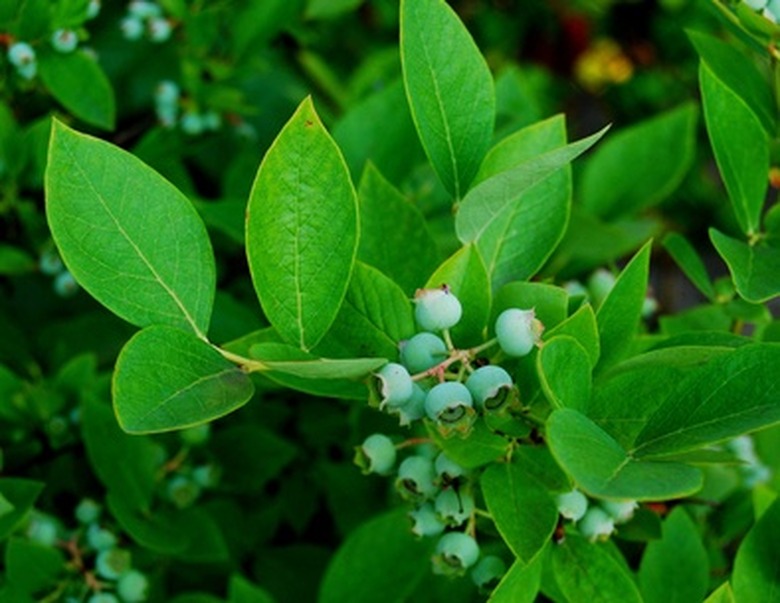How To Clone Blueberry Bushes
Blueberry bushes (Vaccinium cyanococcus) are popular plants in the home garden because they are easy to grow, don't get too large and provide healthy, tasty fruit in mid-summer. Blueberries are a low-calorie snack, and low in cholesterol and sodium, according to the Ohio State University Extension. Clone the blueberry bush in the early spring by taking cuttings from a healthy blueberry bush.
Step 1
Locate an upright-growing branch toward the middle of the plant. Prune off a 6-inch length that includes at least three leaf nodes (swollen area on the stem where the leaf joins it). Make the cut at a 45-degree angle, just above a leaf node. Remove all leaves from the bottom third of the cutting.
- Blueberry bushes (Vaccinium cyanococcus) are popular plants in the home garden because they are easy to grow, don't get too large and provide healthy, tasty fruit in mid-summer.
Step 2
Combine equal parts of moist peat moss and vermiculite. Place the mixture in an 8-inch deep pot and pour water over it until it drains from the bottom of the pot. Create a hole, using your finger or a pencil, for the cutting.
Step 3
Dip the bottom 1 inch of the 45-degree angled end of the cutting into the rooting hormone.
Step 4
Insert the cutting into the prepared hole, burying at least two leaf nodes and leaving at least one node above the soil. Pack the soil around the cutting and use your hands to tamp the soil.
Step 5
Place the pot in a sunny area, on the heating mat, set to 70 degrees Fahrenheit. Water the cutting weekly to maintain moist soil.
- Combine equal parts of moist peat moss and vermiculite.
- Pack the soil around the cutting and use your hands to tamp the soil.
Step 6
Fertilize the cutting after new foliage and roots have formed, usually in June or July, and weekly thereafter. Apply a water-soluble 15-30-4 formulation, at the rate listed on the package.
Step 7
Plant the cutting in its permanent location the following spring.
Bugs Out Of Blueberry Bushes
Pull all weeds in the area surrounding the blueberry bush by hand or, during dormancy, use a broadleaf herbicide containing one of the following active ingredients: glyphosate, dicamba or MCPP. Spray the weeds until dripping or runoff occurs, without allowing any herbicide to come in contact with the bush. Mix 1 part high-grade 70-second superior type dormant petroleum oil to 50 parts tepid water and pour the mixture in a pump sprayer to prevent a thrip infestation. Hang a sticky-strip trap from a branch on the blueberry bush before the berries begin to color to check for blueberry maggot flies. Infected and damaged limbs serve as sources of disease and breeding grounds for insects.
- Fertilize the cutting after new foliage and roots have formed, usually in June or July, and weekly thereafter.
- Pull all weeds in the area surrounding the blueberry bush by hand or, during dormancy, use a broadleaf herbicide containing one of the following active ingredients: glyphosate, dicamba or MCPP.
Things Needed
- Pruning shears
- Peat moss
- Vermiculite
- 8-inch-deep planting pot
- Rooting hormone
- Fertilizer
References
- Ohio State University Extension: Growing Blueberries in the Home Garden
- Northwest Berry & Grape Information Network: Blueberry Propagation
- "The Backyard Berry Book: A Hands-On Guide to Growing Berries, Brambles and Vine Fruit In The Home Garden"; Stella Otto; 1995
- "Modern Fruit Production"; Joseph Harvey Gourley and Freeman Smith Howlett; 1941
- University of North Carolina: Blueberry Pest Management — A Seasonal Overview
- University of Maine: Insects – 209-Insect Control Guide for Wild Blueberries
- Cornell University Cooperative Extension: Do You Have a Blueberry Maggot Problem?
- University of California: Thrips
- University of California: Scales
- National Gardening Association: Blueberry Prescription
